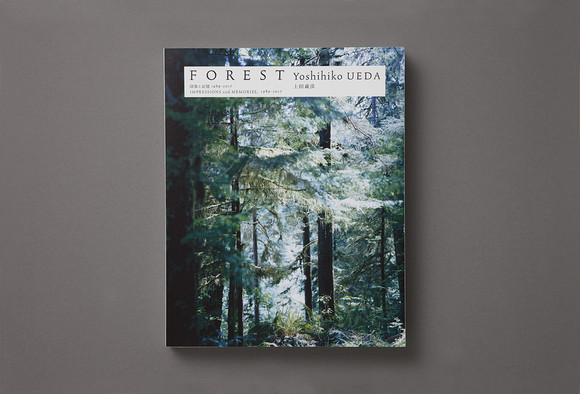FOREST 印象と記憶 1989-2017
2018, Seigensha Art Publishing, 青幻舎
Design : Kenya Hara, Shinpei Nakamura (Nippon Design Center, Inc.)
On Forest: Impressions and Memories 1989–2017
It’s almost 30 years since I began photographing forests, and I have now captured on camera three forests seemingly unrelated, apart from geographically, all being sited on the Pacific Rim: the forest of Quinault in the northwestern United States; Yakushima in the south of the Japanese archipelago; and the virgin forest of the Kasuga Taisha shrine in Nara, central Japan. Crudely put, I suppose you could say my photographing these places was due to force of circumstance, serendipity, some kind of affinity, or suchlike. But actually these three forests share something very important to me: a kind of precious power that compels people to protect them, that has ensured their protection by humans since antiquity. The vital ability to perceive this power has passed down the generations since the dawn of mankind. I feel it myself with great intensity. I have been to many forests, but on encountering these three, found myself seized by a peculiar sensation that drove me to photograph them: a keen sensation that arose from inside of me, impossible to express in words. It was this sensation that prompted me to photograph this trio of forests.
From the earliest years of human history, like other creatures of the land emerging miraculously upon it, people instinctively felt enormous awe at the power of the forest, the power of trees, carrying as they do the source of the power to produce life. Yet over the centuries, at some point this instinctive awe of the forest with which human beings were originally endowed, began to fade.
This is not unconnected, one suspects, to homo sapiens’ mastery of language. Language emerged to enable people to tell others about the state of the world. And over time, the meaning of the primeval source presumably manifested in those words gradually morphed into something conceptual, and symbolic. The language we use today has likely already lost the power to connect directly to the world and our instincts, and allow us to perceive them. The word “forest” no longer inspires our awe. Yet the fact remains that if we go there, stand still, attention focused, eyes and ears open, the “forest” itself will let us know that it still represents something inexpressible in words: a power bigger, something more primeval; a fundamental force possessed by all life. In the forest we may perceive, and observe with our own eyes, the power of this miraculous planet to produce life.
There is also the fact that despite the terrible destruction inflicted on forests purely for human ends in modern times, these forests have been preserved by humans, and other living things, from antiquity right up to the present day. It is with a sense of the incredible power of these forests, their power as the source of all life, and possessed by a fierce desire to capture on film the forest, where the principles and providence of this primeval source revealed to us by this, our planet so wild and yet so delicate, that I suppose I attempt to take photographs of the forest, and am compelled by the forest, to do the taking.
– July 16, 2017
Mid-flight between Beijing and Tokyo
「FOREST 印象と記憶 1989-2017」によせて
僕が森を撮り始めて、30年が経とうとしている。そして今、アメリカ北西部のQuinaultの森と、日本列島の南に位置する屋久島の森、そして、日本の中心部に位置する奈良の春日大社の原生林、地理的には太平洋を挟んで存在するという以外、無関係に思える三つの森を、僕は写真に撮った。乱暴に言えば、行きがかり上、たまたま偶然、縁があって等など。しかし実は、これら三つの森には僕にとって重要な共通点がある。それはこれらの森が太古から人間によって守り継がれてきた、守らねばならないと、人に感じさせる何か大切な力があったからだということ。それを感じとる大事な力を、人は太古から受け継いできた。それを自分自身にも強く感じる。多くの森に僕は出かけた。しかしこの三つの森と出会った時、特別な感覚に襲われ、そして「撮らなければ」と、強く思った。それは言葉にならない、僕の中で起こった鋭い感覚だった。その感覚が僕に、この三つの森を撮らせることになった。
太古の昔から人もこの大地の上に奇蹟的に誕生した生き物として、他の生き物たちと同様に生命を生む力の大元を宿す、森や、木に、本能的に畏怖の念を強く持っていた。しかし長い時間が経ち、いつの頃からか人間に備わったはずの本能的な森に対する畏怖の念は薄れていった。
それは人が言語を操るようになったことと無関係ではない気がする。人間が他者に世界の有り様を伝えるために言葉が生まれた。そして、その言葉が現していたはずの大元の意味は、時とともに次第に概念となり、記号化していった。現在の僕たちが使う言葉は、もはや世界や本能と直結し、それを知覚させるという力を失ってしまったように思える。もはや、「森」という言葉は、僕たちに畏怖の念を覚えさせることはない。しかし依然として、「森」そのものは、そこに行き、注意深く立ち止まり、目と耳を澄ませば、言葉によって表すことの出来ないこと、もっと、大いなる力。もっと、大元のこと。全ての生命が宿す、根源的な力を現し続けていることを知覚させてくれる。この奇蹟の惑星が持つ生命を生む力というものを、僕たちは森という場で知覚し、この目で見ることが出来る。
近代から現代にかけて、これだけ罰当たりに、人間の都合だけで森を壊してきたにもかかわらず、これらの森は、太古より今日まで、人や生き物によって守られてきたのだという事実。これらの森の持つ大いなる力、生命を生む大元の力を感じ、その荒々しくも繊細な、この地球という惑星が見せてくれる根元的な大元の原理や摂理を、今も目に見える形で現している森の姿を写真に撮りたいと強く感じ、僕は森を撮ろうとするのだろうし、森に撮らされているのだろう。
– 2017年7月16日
北京より東京への機上にて
